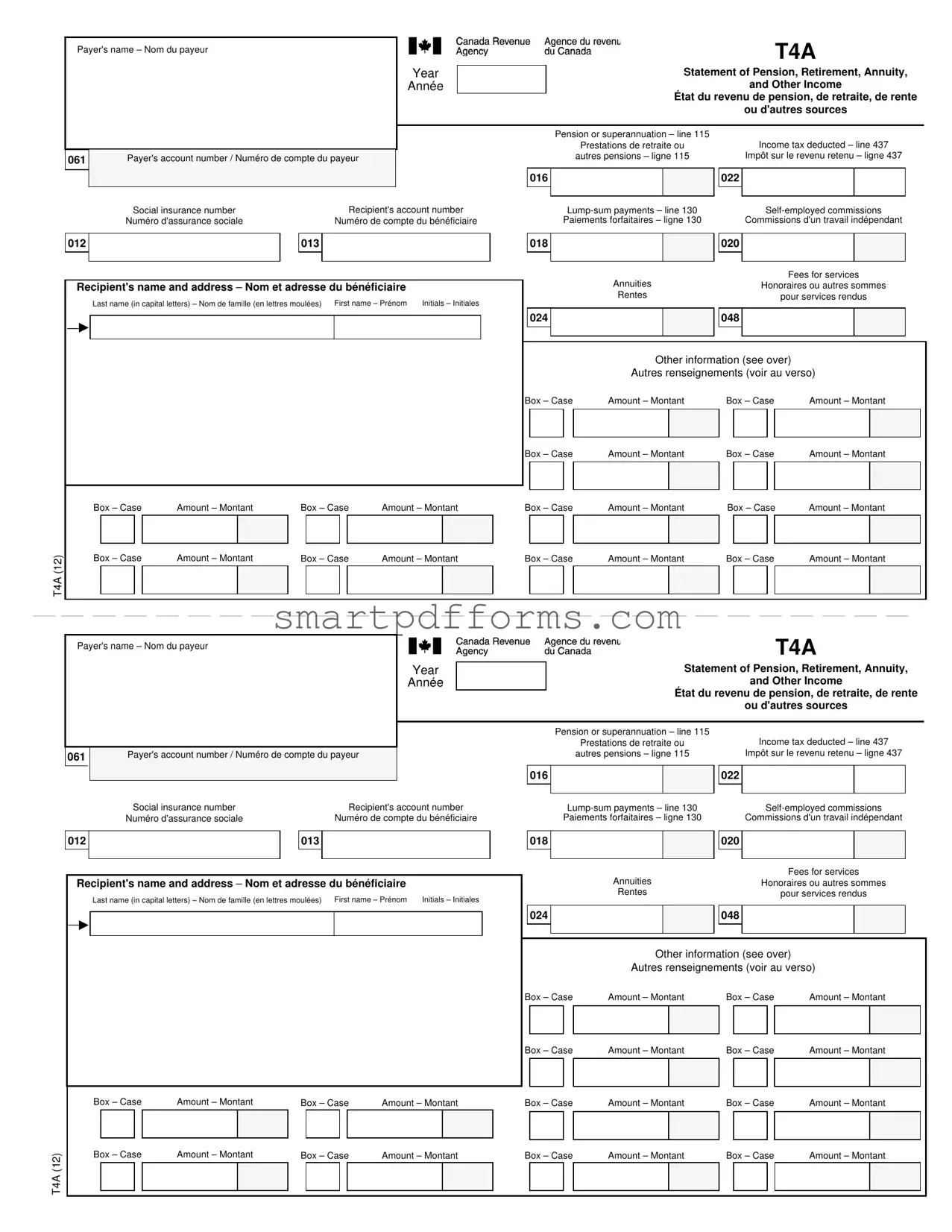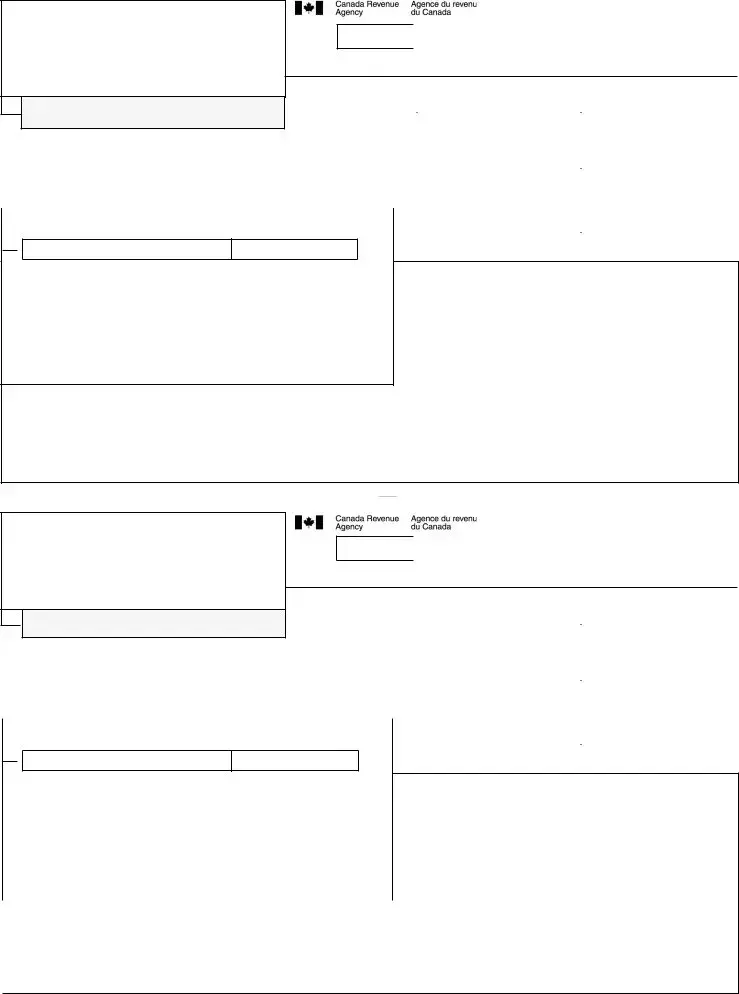Déclarez ces montants dans votre déclaration de revenus.
Case 016, Prestations de retraite ou autres pensions – Inscrivez ce montant à la ligne 115. Vous pourriez avoir droit au montant pour revenu de pension (lisez la ligne 314 de votre guide d'impôt).
Case 018, Paiements forfaitaires – Inscrivez ce montant à la ligne 130.
Les montants figurant dans les cases suivantes sont inclus dans la case 018 :
Case 102, Paiements forfaitaires – transfert de services de non-résidents en vertu de l'alinéa 60j) Case 108, Paiements forfaitaires d'un régime de pension agréé (RPA) non admissible à un transfert Case 110, Paiements fortaitaires accumulés avant le 31 décembre 1971
Case 158, Paiements forfaitaires non admissible à un transfert, et qui ne sont pas déclarés ailleurs Case 180, Paiements forfaitaires versés à partir d'un RPDB non admissible à un transfert
Case 190, Paiements forfaitaires – Prestations d'un régime de pension non agréé
Case 020, Commissions d'un travail indépendant – Inscrivez le montant brut de vos revenus de commissions
àla ligne 166 et le montant net de vos revenus de commissions à la ligne 139. Case 022, Impôt sur le revenu retenu – Inscrivez ce montant à la ligne 437.
Case 024, Rentes – Lisez la ligne 115 de votre guide d'impôt.
Les montants figurant dans les cases suivantes sont inclus dans la case 024 : Case 111, Contrat de rentes à versement invariable (CRVI)
Case 115, Paiements d'une rente ou versements selon un régime de participation différée aux bénéfices (RPDB)
Case 026, Allocations de retraite admissibles (pour l’année 2009 et les années précédentes seulement) – Inscrivez ce montant à la ligne 130. Il se pourrait que ce montant soit transférable en partie ou en totalité dans un REER ou dans un régime de pension agréé. Lisez la ligne 130 de votre guide d'impôt.
Case 027, Allocations de retraite non admissibles (pour l’année 2009 et les années précédentes seulement) – Inscrivez ce montant à la ligne 130.
Case 028, Autres revenus – Montants non déclarés à d'autres endroits sur le feuillet T4A. Lisez la ligne 130 ainsi que les lignes 135 à 143 de votre guide d'impôt.
Case 030, Répartitions selon l'apport commercial – Inscrivez ce montant à la ligne 130. Ne déclarez pas ce montant s'il concerne des produits de consommation ou des services dont vous ne pouvez pas déduire le coût dans le calcul de votre revenu. Ce montant ne vous donne pas droit au crédit d'impôt fédéral pour dividendes.
Case 032, Cotisations à un régime de pension agréé (services passés) – Inscrivez le montant que vous pouvez déduire à la ligne 207 (consultez le guide T4040, REER et autres régimes enregistrés pour la retraite).
Case 126, Cotisations pour périodes de services avant 1990 (incluses dans la case 032)
Case 034, Facteur d'équivalence – Inscrivez ce montant à la ligne 206. Ce montant n'est ni un revenu ni une déduction.
Case 040, Paiements de revenu accumulé d'un REEE – Inscrivez ce montant à la ligne 130. Vous devez aussi remplir le formulaire T1172, Impôt supplémentaire sur les paiements de revenu accumulé de REEE.
Case 122, Paiements de revenu accumulé d'un REEE payé à un tiers (inclus dans la case 040)
Case 042, Paiements d'aide aux études d'un REEE – Inscrivez ce montant à la ligne 130. Pour en savoir plus, consultez la feuille de renseignements RC4092, Les régimes enregistrés d'épargne-études.
Case 046, Dons de bienfaisance – Lisez la ligne 349 de votre guide d'impôt.
Case 048, Honoraires ou autre sommes pour services rendus – Inscrivez ces montants comme revenu d'entreprise.
Case 133, Prestations de retraite variables – Lisez la ligne 115 de votre guide d'impôt. Case 135, Primes versées à un régime privé d'assurance-maladie – Lisez la ligne 330 de votre guide d'impôt.
Inscrivez à la ligne 104 :
Case 104, Subventions de recherche – Lisez la ligne 104 de votre guide d'impôt.
Case 107, Paiements reçus d'un régime d'assurance-salaire – Lisez la ligne 104 de votre guide d'impôt.
Case 118, Avantages pour primes de soins médicaux
Case 119, Primes payées pour une police d'assurance-vie collective temporaire Case 127, Prestations pour anciens combattants
Case 132, Programme de protection des salariés
Case 152, PSC admissible à ce titre en vertu de la Loi de l'impôt sur le revenu Case 156, Règlements d'une société en faillite
Inscrivez à la ligne 125 :
Case 131, Régime enregistré d'épargne-invalidité
Inscrivez à la ligne 130 :
Case 105, Bourses d'études, de perfectionnement et d'entretien; subventions reçues par un artiste pour un projet et récompenses – Lisez la ligne 130 de votre guide d'impôt.
Case 106, Prestations consécutives au décès – Lisez la ligne 130 de votre guide d'impôt. Case 109, Paiements périodiques d'un plan non agréé
Case 117, Avantages liés à un prêt
Case 123, Paiements provenant d'un RPDB dont l'agrément a été retiré
Case 125, Prestations d'invalidité payées à même un régime de prestations de retraite ou d'autres pensions
Case 129, Part de votre coopérative à imposition différée
Case 130, Subvention incitative aux apprentis ou à l'achèvement de la formation d'apprenti Case 134, Compte d'épargne libre d'impôt (CELI) – montant imposable
Case 150, Loi sur les prestations d'adaptation pour les travailleurs et Lois de crédits Case 154, Prime en espèces ou prix payé d'un payeur


